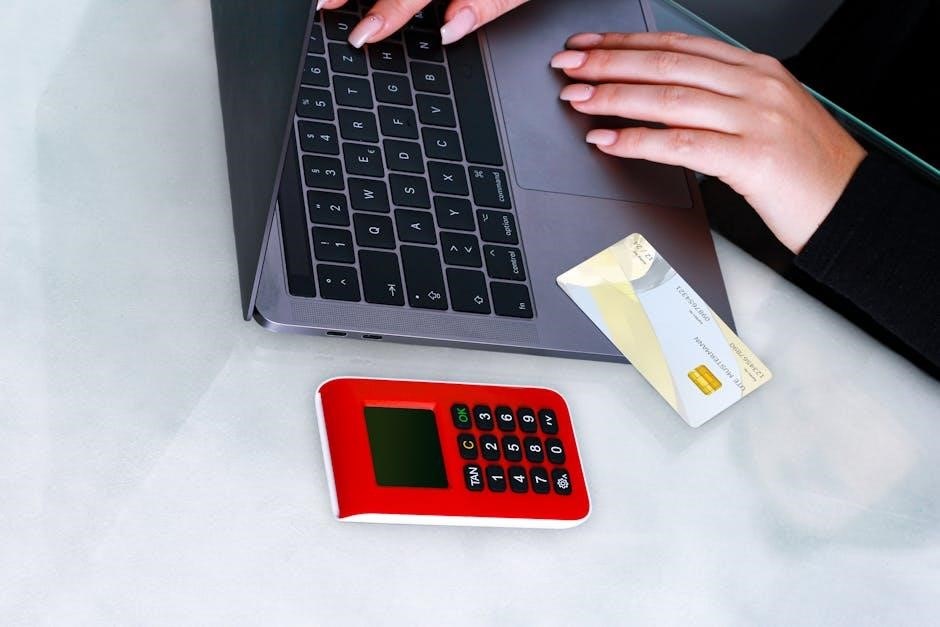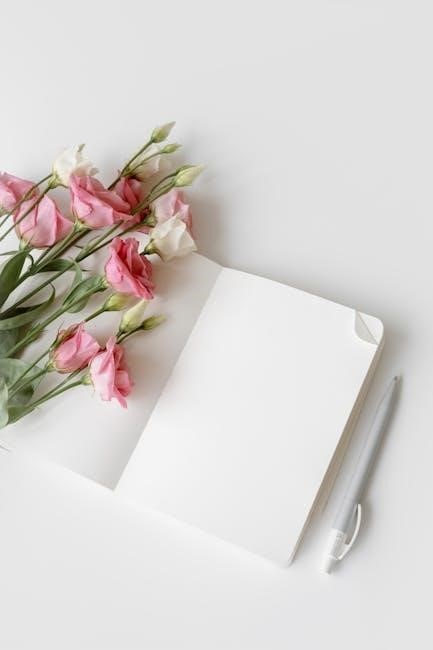A DBT Diary Card is a tool used to track emotions, urges, and behaviors daily, aiding in identifying patterns and monitoring progress in DBT skills.
1.1 What is a DBT Diary Card?
A DBT Diary Card is a personalized tool used in Dialectical Behavior Therapy to track emotions, urges, and behaviors daily. It helps individuals monitor their progress, identify patterns, and record the use of DBT skills. The card typically includes sections for rating emotions, noting target behaviors, and documenting skills practiced. It is often printed on 4×6 card stock, with the front side focusing on emotions and behaviors, and the back side dedicated to skills training. This tool is essential for both clients and therapists to review progress during sessions.

1.2 Importance of Diary Cards in DBT
DBT Diary Cards are crucial for tracking emotions, behaviors, and skill use, helping individuals identify patterns and areas for improvement. They provide a clear overview of daily progress, enabling clients to prepare for therapy sessions and therapists to understand their clients’ needs better. By documenting emotions and behaviors, the diary card fosters accountability and self-awareness, which are essential for personal growth and skill development in DBT. Regular use of the diary card enhances the effectiveness of therapy and supports long-term behavioral change.
1.3 Benefits of Using a DBT Diary Card
Using a DBT Diary Card offers numerous benefits, including improved self-awareness, emotional regulation, and skill development. It helps track emotions, behaviors, and skill use, identifying patterns and areas for growth. By documenting daily experiences, individuals gain clarity on their mental health journey. The diary card also enhances accountability, encouraging consistent practice of DBT skills. Its structure allows for personalized adjustments, making it adaptable to individual needs. Regular use fosters better decision-making and supports personal growth, ultimately strengthening the effectiveness of therapy sessions and daily life management.

Structure of a DBT Diary Card
A DBT Diary Card is structured into front and back sides. The front tracks emotions and behaviors, while the back focuses on skills training and progress.
2.1 Front Side: Tracking Emotions and Behaviors
The front side of a DBT Diary Card is designed to track emotions, urges, and target behaviors daily. It includes sections for rating the intensity of emotions and urges on a scale of 0 to 5. Users can also note specific emotions like fear, sadness, or anger, and document any self-harm urges or actions. Additionally, it provides space to record behaviors related to targets such as substance use or other harmful actions. This side is primarily used in individual therapy to review progress and identify patterns, with the “Used Skills” column also relevant for skills training sessions. The card is printed on 4×6 card stock, front and back, ensuring portability and ease of use.
2.2 Back Side: Skills Training and Progress
The back side of a DBT Diary Card focuses on documenting the use and effectiveness of DBT skills. It includes a checklist of skills such as mindfulness, distress tolerance, and emotional regulation, allowing users to track which skills were practiced daily. Additionally, there is space to rate how helpful each skill was on a scale of 0 to 5. This side is primarily used during skills training sessions to review progress and identify which skills need further practice. It also provides insight into how effectively skills are being applied in real-life situations, aiding in personal growth and therapy outcomes.
2.3 Key Components of the Diary Card
A DBT Diary Card includes sections for tracking emotions, target behaviors, and skill usage. It features a checklist of DBT skills, rating scales for effectiveness, and space for notes. The card is designed to be concise, fitting on a 4×6 card stock, with the front for emotions and behaviors, and the back for skill tracking. Key components ensure comprehensive monitoring of progress, helping users identify patterns and areas for improvement. This structure makes it easy to review during therapy sessions, enhancing accountability and personal growth.

How to Use a DBT Diary Card
Track emotions, urges, and behaviors daily on the front side. Review and reflect during therapy, using the back side to monitor skill use and progress effectively.
3.1 Daily Tracking of Emotions and Urges
Daily tracking involves rating emotions and urges on a scale (0-5) to monitor intensity. Note specific emotions like fear, anger, or sadness, and urges such as self-harm or substance use. Record these on the front side of the DBT diary card, along with any behaviors acted upon. This helps identify patterns and triggers, enabling better preparation for therapy sessions. Tracking skills used, such as mindfulness or distress tolerance, adds depth to the process, fostering accountability and progress in managing emotions effectively over time.
3.2 Monitoring Skill Use and Effectiveness
The back side of the DBT diary card is used to monitor DBT skill use and effectiveness. Skills like mindfulness, distress tolerance, and emotional regulation are tracked daily. Users rate how often they used each skill and its effectiveness on a scale. This helps identify which skills are most helpful and where more practice is needed. By documenting skill use, individuals can review patterns and discuss progress with their therapist, fostering a more focused and productive therapy experience.
3.3 Reviewing and Reflecting on Progress
Reviewing and reflecting on your DBT diary card helps identify patterns in emotions, urges, and skill use. Regular reflection enhances self-awareness and personal growth. By discussing the diary card in therapy, individuals can explore challenges and celebrate progress. This process aids in understanding which skills are most effective and where more practice is needed. Reflecting on the diary card fosters accountability and motivates continued effort in managing emotions and behaviors, ultimately promoting long-term personal development and emotional well-being.

Where to Find Free DBT Diary Card PDFs

Free DBT diary card PDFs are available on official DBT websites, therapy resources, and platforms offering mental health tools. Customize templates to suit your needs.
4.1 Reliable Sources for Download
Reliable sources for free DBT diary card PDFs include official DBT websites, mental health portals, and therapy resources. Websites like DBT Skills Coaching, My Daily DBT, and BetterHelp offer downloadable templates. Additionally, platforms such as Therapy Tools and Mental Health Resources provide customizable and printable versions. These sources ensure high-quality, therapy-approved materials tailored for personal or clinical use. Always verify the credibility of the source to ensure the diary cards align with DBT principles and practices. Downloading from trusted sites guarantees accuracy and effectiveness in tracking emotions and skills.
4.2 Websites Offering Customizable Templates
Websites like Canva, Etsy, and Google Drive offer customizable DBT diary card templates. These platforms provide editable PDFs, allowing users to tailor sections to their specific needs. Some templates include predefined skills lists, while others offer blank spaces for personalization. Canva’s drag-and-drop feature simplifies design, making it easy to create visually appealing cards. Etsy sellers often provide detailed, professional layouts. Google Drive templates are easily downloadable and sharable, facilitating collaboration with therapists. These resources empower individuals to create diary cards that suit their unique mental health journeys, enhancing their effectiveness and engagement.
4.3 Tips for Selecting the Right Template
When choosing a DBT diary card template, consider your specific needs and preferences. Look for templates that allow customization to include relevant skills or emotions. Ensure the layout is clear and easy to navigate. Opt for templates with predefined sections for emotions, urges, and skill use to streamline tracking. Check if the template is compatible with your device or printer. Lastly, read reviews or previews to confirm the template aligns with your goals and is user-friendly for consistent daily use.

How to Download and Print DBT Diary Cards
Visit reliable websites offering free DBT diary card PDFs. Select a template, download it, and print on 4×6 cardstock for optimal usability and portability.
5.1 Step-by-Step Download Instructions
To download a DBT diary card PDF for free, start by visiting a reliable website offering such templates.Browse the available options and select the one that best fits your needs.Click the “Download” button to save the PDF to your device.Open the file using a PDF reader and review its contents to ensure it aligns with your goals.Print the diary card on 4×6 cardstock for optimal portability and usability.Customize the template if needed, and begin using it daily to track your emotions, behaviors, and skill use effectively.
5.2 Printing Tips for Optimal Results
For optimal printing of your DBT diary card, use 4×6 cardstock to maintain its portability. Print on both sides to utilize the front for emotions and the back for skills. Ensure your printer is set to “Actual Size” to avoid resizing issues. Choose high-quality print settings for clarity. Use a laminator if available to protect the card from wear. Consider binding multiple cards together for easy access. This ensures your diary card remains durable and user-friendly for daily tracking and reflection.
5;3 Ensuring Compatibility with Your Needs
To ensure your DBT diary card meets your needs, assess your goals and preferences. Customize sections to focus on specific emotions, skills, or behaviors relevant to your therapy. Check the layout for clarity and ease of use, ensuring it aligns with your daily routine. If using in therapy, verify that the format complements your sessions. Select templates that allow for personalization, such as adding or modifying categories. This tailored approach enhances its effectiveness as a tool for tracking progress and fostering personal growth in DBT practices;

Customizing Your DBT Diary Card
Customize your diary card by adding personalized sections, modifying layouts, and incorporating additional skills or categories to tailor it to your specific needs and therapy goals.
6.1 Adding Personalized Sections
Personalizing your DBT diary card enhances its effectiveness by making it relevant to your unique experiences. Consider adding sections for specific emotions, coping mechanisms, or personal goals. For example, if you frequently encounter anxiety, include a section to track anxiety triggers and how you manage them. You can also add columns for noting progress in therapy sessions or space to record insights from skills practiced. This customization ensures the diary card aligns with your personal growth and therapeutic objectives, making it a more powerful tool for self-reflection and progress tracking. Effective customization helps maintain consistency and motivation in your DBT journey.
6.2 Modifying Layout for Better Usability
Adjusting the layout of your DBT diary card can significantly improve its usability. Consider prioritizing frequently used sections, such as emotions or skills, by placing them prominently. Use larger boxes for sections requiring detailed input, ensuring ample space for notes. Avoid clutter by organizing sections logically, grouping similar categories together. Enhance readability by using clear headings and sufficient white space. For digital versions, experiment with fonts and colors to make the card visually appealing and easy to navigate. A well-designed layout fosters consistency and makes the diary card a more practical tool for daily tracking and reflection.
6.3 Incorporating Additional Skills or Categories
Customizing your DBT diary card by adding extra skills or categories can enhance its effectiveness. Consider including sections for mindfulness practices, self-care activities, or personal goals. You might also add categories for tracking specific behaviors or emotions relevant to your journey. Incorporating skills like “Describe” or “Participate” from DBT mindfulness techniques can deepen your practice. Additionally, including a section for daily reflections or gratitude can promote further growth. Tailoring the card to your unique needs ensures it remains a relevant and powerful tool for managing emotions and behaviors effectively over time.

Common Challenges When Using DBT Diary Cards
Common challenges include forgetting to fill out the card daily, emotional resistance to tracking painful feelings, and complexity in managing multiple metrics consistently over time.
7.1 Overcoming Consistency Issues
Consistency is key to maximizing the benefits of DBT Diary Cards. To overcome inconsistency, set a specific daily routine, such as filling out the card at the same time each day. Pairing this task with another habit, like right after breakfast or before bed, can help make it automatic. Additionally, keeping the diary card in an easily accessible place, like a wallet or purse, serves as a constant reminder. Rewarding oneself for consistent use can also motivate adherence. Over time, this practice becomes a ingrained part of daily life, enhancing its effectiveness in tracking emotions and behaviors.
7.2 Dealing with Emotional Resistance
Emotional resistance to using DBT Diary Cards is common, often stemming from fear of confronting difficult emotions or feelings of overwhelm. To address this, start by acknowledging the resistance without judgment. Break the task into smaller, manageable steps, such as filling out one section at a time. Remind yourself of the long-term benefits, like gaining insight into patterns and improving emotional regulation. If resistance persists, discuss it with your therapist, who can help you explore underlying causes and develop strategies to move forward. Celebrate small victories to build motivation and persistence.
7.3 Managing Complexity of Tracking
Managing the complexity of tracking emotions, urges, and skills on a DBT Diary Card can feel overwhelming. To simplify, focus on the most relevant sections and prioritize consistency over perfection. Use pre-defined scales for emotions and urges to streamline the process. If tracking multiple skills becomes too much, start with one or two and gradually add more. Regularly review your card to identify patterns and adjust your focus as needed. Remember, the goal is progress, not perfection. Simplify the process to make it sustainable and meaningful for your journey.

Tips for Effective Use of DBT Diary Cards
Stay consistent, review patterns, and use cards in therapy. Keep it simple, focus on key skills, and reflect regularly to enhance mental health progress and self-awareness.
8.1 Staying Consistent and Committed
Consistency is key to maximizing the benefits of DBT Diary Cards. By tracking emotions, urges, and skills daily, you build awareness and identify patterns over time. Commitment to regular use ensures progress in managing emotions and behaviors. Set reminders or keep the card in an accessible place to maintain your routine. Over time, this practice becomes a habit, fostering personal growth and skill mastery. Stay dedicated to see lasting changes in emotional regulation and overall mental health.
8.2 Using the Diary Card in Therapy Sessions
Integrating the DBT Diary Card into therapy sessions enhances treatment effectiveness. The card provides a clear overview of your progress, emotions, and skill use, allowing your therapist to identify patterns and areas for focus. Regularly reviewing the card during sessions helps set goals and celebrate successes. By sharing insights and challenges, you and your therapist can collaborate more effectively, ensuring targeted interventions and personalized strategies for emotional growth. This collaborative approach strengthens the therapeutic relationship and accelerates skill development.
8.3 Leveraging Patterns for Personal Growth
Identifying patterns in your DBT Diary Card helps you understand triggers and responses, enabling targeted skill development. By recognizing recurring emotions or behaviors, you can address root causes and modify reactions. This awareness fosters personal growth by enhancing self-regulation and resilience. Over time, leveraging these insights allows you to anticipate challenges and apply skills more effectively, promoting long-term emotional well-being and alignment with your values. This process is central to DBT, helping you move from reacting to observed experiences. Regular reflection on patterns ensures continuous improvement and mindful living.
DBT Diary Cards are effective tools for tracking emotions and skills, promoting self-awareness and personal growth. Regular use fosters resilience and emotional well-being, encouraging long-term progress.
9.1 Summary of Key Points
A DBT Diary Card is a powerful tool for tracking emotions, behaviors, and skill use, helping identify patterns and monitor progress in Dialectical Behavior Therapy. It aids in self-awareness, emotional regulation, and personal growth. The card is structured to include daily tracking of emotions and urges, skill effectiveness, and progress reflection. Available as free PDFs, these templates are customizable to individual needs, offering a practical resource for therapy sessions and independent practice. Consistent use enhances resilience and fosters a deeper understanding of emotional responses and coping strategies, promoting long-term mental well-being.
9.2 Final Thoughts on Using DBT Diary Cards
DBT Diary Cards are invaluable for fostering self-awareness and emotional regulation. By consistently tracking emotions, urges, and skill use, individuals can identify patterns and make informed decisions. The diary card serves as a bridge between therapy sessions, enhancing accountability and progress. Its portability and customizable nature make it a flexible tool for personal growth. Embracing this practice can lead to significant improvements in managing emotions and behaviors, ultimately contributing to a more balanced and fulfilling life. Continued use reinforces resilience and strengthens coping strategies, making it a cornerstone of effective DBT practice.
9.3 Encouragement for Continuous Practice
Embracing DBT Diary Cards as a daily habit can lead to profound personal growth. Consistent practice helps build resilience, enhances emotional regulation, and fosters a deeper understanding of your behaviors. By committing to this tool, you take a proactive approach to mental health management. Celebrate small victories and remind yourself that progress, not perfection, is the goal. Over time, the diary card becomes more than a tracker—it’s a testament to your dedication to healing and self-improvement. Keep going; every entry brings you closer to your goals.
